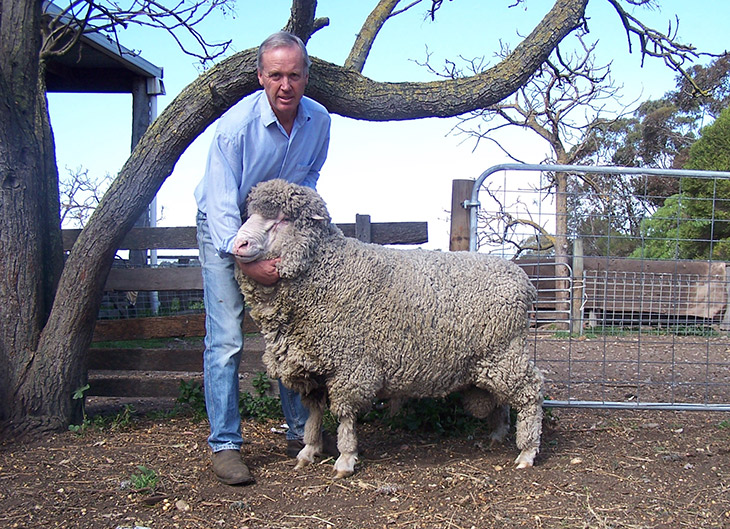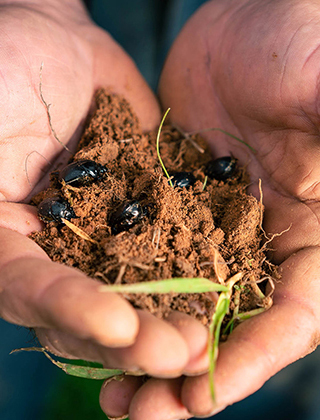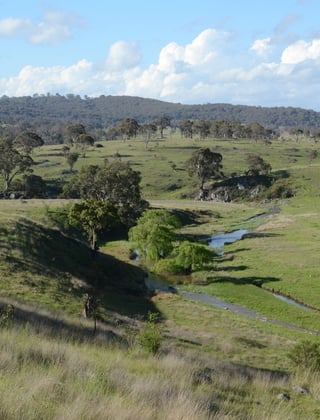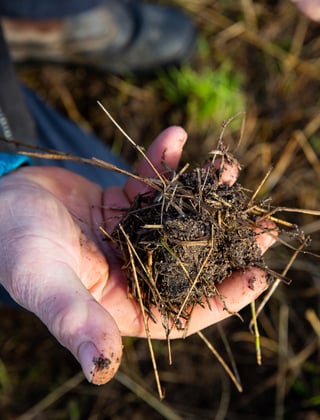Modern climate management

Rick and Jenny Robertson from East Gippsland in Victoria have increased the resilience of their Merino business by moving to a grazing system suited to the increasingly variable climate.
Finalist in the recent Weekly Times Coles farmer of the year competition, Rick Robertson on his property near Bairnsdale in Victoria.
Rick and Jenny Robertson from East Gippsland in Victoria have increased the resilience of their Merino business by moving to a grazing system suited to the increasingly variable climate.
Rick and Jenny Robertson’s 1,000-hectare property at Bengworden, near Bairnsdale in Victoria, has been in the family for 70 years. Rick's father bought the property in 1950 to breed Merinos for fine wool, and Rick continues that tradition.
“Merino breeding is the only thing I have wanted to do since leaving school,” Rick said. “We join 3,000 and have no wethers over one year of age. Our Merino breeding operation also includes a stud, and crossbred lambs are produced from second grade ewes.”
Rick and Jenny were finalists in the most recent Weekly Times Coles farmer of the year competition.
The catalyst for change
During the 1980s and 1990s, the Robertsons ran a high input system with their sheep set stocked, grazing across large landscapes on their property. A run of droughts and poor seasons resulted in poor ground cover, reduced stock numbers and regularly having to buy feed for summer feeding out. The collapse of the wool reserve price scheme in the 1990s and poor commodity prices compounded financial difficulties for the Robertsons’ business.
It was not until the end of 2008 that things changed for the better, after the Robertsons watched an inspiring episode of ABC Landline about NSW Farmer of the Year Nigel Kerin’s success with time controlled rotational grazing.
“It was during another dry run of years, and our three daughters were all at home watching Landline with us. The NSW Farmer of the Year was on the program showing how he farms successfully irrespective of whether the seasons are good or bad. At the end of the program, the girls encouraged me to give it a go. I had already done the training without implementing it, so we just decided there and then to change the way we farm,” Rick explained.
“Climate change with the too frequent dry years was a major catalyst for change. Rainfall has been below average for a third of the past 40 years and the average has fallen 15%. In the high stocking rate system, there was a constant roller coaster of excessive fodder bills, erratic lambing percentages, and poor stock performance. The risk and stress were too high.”
Since then, the Roberstons’ business philosophy has been to adopt a lower risk, more sustainable system of managing livestock and the land. Although the change has been challenging, it has provided new opportunities whilst at the same time making the Roberstons feel more in control of their business.
Rick says that by changing the way they farm, they have created a more resilient farming system in a low-rainfall environment.
“We operate a system of ‘modern climate management’ where we work with the rainfall we receive and adjust our sheep numbers down when the rains fail. Having three months standing feed at all times and a mob identified as ‘ready to sell’ takes out the roller coaster ride of profit and loss, weaning percentages and fodder bills.”
Rotational grazing improves pasture resilience
The Robertsons introduced rotational grazing by dividing up their paddocks into smaller sizes. Sheep are run in larger mobs, at a higher density for short periods of time, and then rotated around the different paddocks. (At lambing, they greatly reduce the mob size and allow the sheep to graze for longer periods.)
With paddocks rested for two to three months between grazing, the grass has plenty of time to recover and grow strongly before the next grazing. Animals graze more evenly and knock down dry grasses, creating a mulch layer from which organic matter is added to the soil. This improves the soil’s water-holding capacity rather than rain flowing straight off the property into the Gippsland Lakes.
“We now have 75 paddocks, up from about 30 previously, each now sized about 15 hectares. We rotationally graze each paddock for four to five days with fewer but larger mobs, except when lambing. Each three-month rest allows the grass to grow larger solar panels (leaves) which increases the dry matter production compared to set stocking,” Rick said.
“The benefits include better ground cover, deeper roots accessing moisture and nutrients, and greater persistence of the important perennials.
“Grazing of longer leaves results in sloughing off of the roots which increases organic matter and leads to higher carbon levels. A one percent increase in carbon levels increases the water holding capacity by 160,000 litres per hectare. And with 10% of the property under trees, 90% of our enteric emissions are offset.”
The new system has meant that ground cover has improved substantially to 100% ground cover throughout the year. Whereas previously it took longer for the pasture to recover after a dry period, better ground cover means a much quicker bounce back after rain because the pasture is making the best use of whatever rain it receives.
Additional hand feeding is only ever used to optimise weaner growth rates under the Grow program (a service now offered by Elanco Animal Health), which has substantially reduced their business’s costs. This is an example of keeping the risk out of their farming system and developing better resilience in the whole system for tough times.
Improved pastures and landscape
The Robertsons have seen a noticeable improvement in their pastures. Their goal has been to get perennial grasses back into the system because they have a deeper root system that can access water at a lower level and respond well to rainfall. Rick believes that set stocking can be tough on perennials whereas rotational grazing increases their number and diversity.
“We have expanded our areas of perennial grass. Exotic perennials are the focus when sowing new pasture because they suit our continental environment,” he said.
“Multi species cover crops are also used to fill feed gaps with highly digestible, high energy and protein fodder at half the cost of bought grain to grow young sheep. Up to 10 species are sown together – we find this gives better rumen/gut health and growth rates compared to mono crops.”
The Robertsons manage their stocking rates according to how much rainfall they receive.
“We run at district average stocking rate or slightly lower,” Rick said.
Profit not production
“There is a push by some farmers, consultants and resellers to run excessive stocking rates and quote high numbers, but we find our business risk is lower and profit levels more consistent. We can’t control the weather or prices, but we can control the costs. We are not trying to outproduce our environment,” Rick said.
The Robertsons have also been passionate advocates for Landcare and, even prior to changing their farming system, had established kilometres of shelterbelts and tree planting across the property. Salt affected land adjacent to the foreshore of the Gippsland Lakes had also been reclaimed with a 10-hectare plot of saltbush.
Improvements in wool quality and sheep health
Rotational grazing has benefited the performance of the Robertsons’ flock by providing a consistent level of nutrition throughout the year.
Rick says their wool cut and tensile strength have improved.
“Under this new system, our fleece weights are up by 0.5 kg per head to 6.0 kgs per head of 18.9 micron wool without the erratic swings of the bad old days. Light soils in this district restrict the amount of wool you can stack on a Merino without compromising doing ability and fertility on grass alone. One kilo of wool per 10 kilos body weight seems the right balance,” Rick said.
“Another benefit is our foetal retention rate and marking percentages are consistently respectable compared to the high intensity figures we see. Last year, our maiden ewes scanned only 2% empty and the mixed age ewes had only 3% empty after the year from hell. 90% of scanned foetuses make the lamb marking cradle even in dry years.”
Pregnancy scanning enables the Robertsons to separate multiple-bearing ewes from single-bearing ewes and manage their feed requirements accordingly.
Their animal health costs have also decreased significantly because a major benefit of implementing the rotational grazing system is that the sheep are regularly moved onto clean paddocks, thereby reducing their worm burdens. Their reduced drenching is based on worm egg counts.
The modern Merino shows its worth
Rick says he strongly believes the Merino is still the most profitable breed of sheep, because it has multiple income sources.
“With wool sales now 45% of turnover and sheep sales 55%, the emphasis has obviously to be on fertility. Also, current Merino ewe prices are often three times the value of the fleece so we will continue to sell ewes SIL (scanned in lamb), LAF (lambs at foot) or with rams to maximise sale price. Some groups of progeny are now often 2-3 times the value of the ewe’s fleece at a young age. Merinos are only being shorn 3.5 times on average in the industry; the focus has changed,” he said.
“For many years we called ourselves woolgrowers; a more appropriate description these days is sheep breeders because there are so many more aspects to the package that affect the phenotype and genotype of this modern Merino.
“Wool is my great interest but over the past 10 years I have added fat, muscle and growth rate allowing us to join our ewe lambs at eight months, which is very uncommon at this latitude. The plain bodied modern Merino has other benefits – including rearing twins that are similar to singles, a lower culling rate at classing (20%) and having culls that are not over skinned, small and unsaleable.
“Selection of rams and ewes with feet that are the right shape and length, no dag, and a breech wrinkle score of 2 or less allowed us to stop mulesing. The message is clear from the wool buying fraternity – wool that is from mulesed sheep will be discounted, especially at the finer end. And don’t be surprised if the same applies to sheep meat. We still use long acting Buccalgesic pain relief during lamb marking.”
Rick has calculated some figures on the profitability of the different types of sheep – and he says the “hype” around lamb production needs to be put into perspective.
“The gross returns of wool, lamb, and surplus sales less replacements, converted to a DSE figure in districts with around 500-600ml make interesting reading: Merino $135, Border Leicester/Merino cross $115, composite $110,” he said.
“Some districts will of course be too wet for Merinos and others too dry for composites, yet some producers may be surprised by the figures. And Merinos don’t need as much rocket fuel feed to achieve a result compared to the cross bred types that rely on a legume-dominant pasture.”
An improved business and lifestyle
The shift in their farming system means that the business’s finances have effectively turned around from a loss to a profit and improved gross margins. The Robertsons feel much more in control of their future.
“We have a policy of balancing our three important inventories: grass, money and livestock. A deficit, and in some cases a surplus, of an inventory can be dangerous to the business,” Rick explained.
“For example, too many stock and a deficit of grass leads to perennial grass dieback, large fodder bills and poor stock performance. Running out of grass leads to increased debt. Of course, on the other hand, too few animals can be a lost opportunity.”
As well as their farm now being in a healthier financial position than it was 12 years ago, it has also provided the Robertsons with a better lifestyle and more time to spend on other activities.
This article appeared in the June 2021 edition of AWI’s Beyond the Bale magazine. Reproduction of the article is encouraged, however prior permission must be obtained from the Editor.















